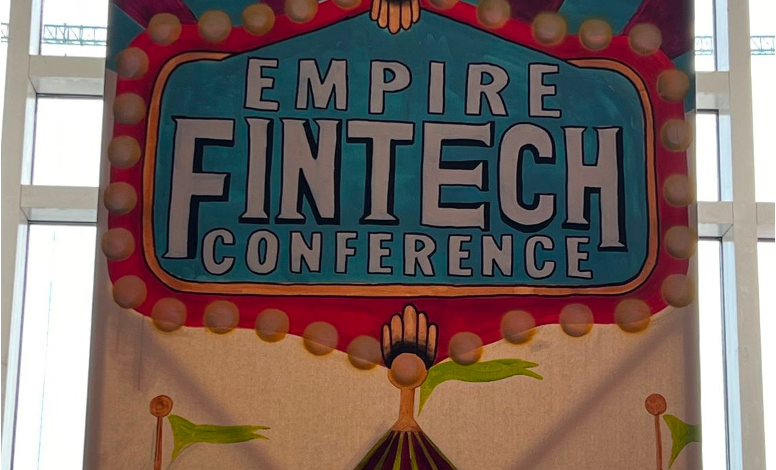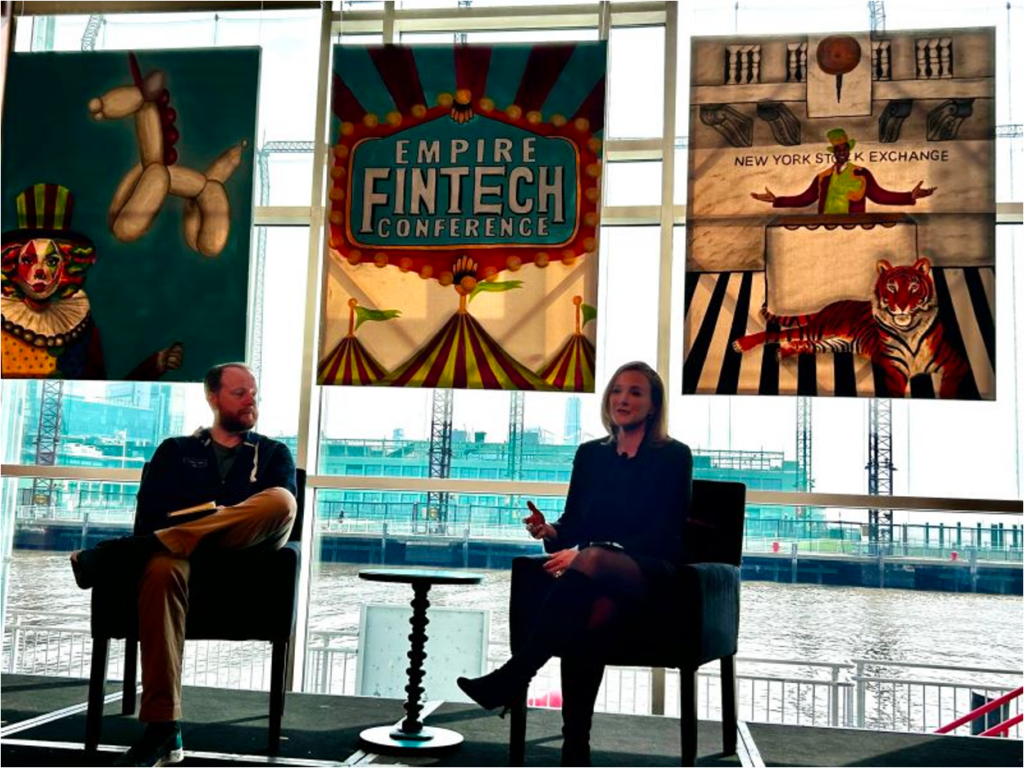New York Fintech Week Reflections –

Let’s start with a theory – there is an ideal size for everything.
A class of 15-20 students works great; a class of 40 is a mess. A software company with 400 employees is a dream to work for; a software company with 4,000 is a bureaucratic nightmare. An industry event with 1,000 attendees is fun and informative; an industry event with 10,000 attendees is a zoo.
The problem is that, historically, the best way to make money was through scale. Bigger meant more operationally efficient. Bigger meant more brand awareness. Bigger meant wider competitive moats.
Bigger meant winning. So we tried to grow things as big as possible, and in so doing, we often ruined what was awesome about them.
We knew we were ruining them – reducing their value through bloat – but we didn’t stop. We couldn’t. Our economic incentives compelled us to make them bigger.
Until now, perhaps.
I think technology may have advanced to the point where the economic incentives towards bigness are starting to be weakened. If the internet reduces the cost of distribution and improves discoverability, is there really as much value in broad-based brand awareness as there used to be? If generative AI really can revolutionize human efficiency, could someone build a one-person unicorn?
Could curating a small industry event with a high density of the right attendees and sponsors become more valuable than hosting a massive industry event with the maximum number of attendees and sponsors?
This was a thought that occurred to me while I was attending the Empire Fintech Conference during this week’s New York Fintech Week.
Empire is always one of my favorite events (shoutout to the tireless Jon Zanoff and his small but mighty team!), and I think the main reason is that it’s not that big. This year’s event had, I think, about 700 attendees and a small number of highly relevant sponsors, and it was perfect. If you were trying to meet with someone specific, you could easily find them. If you were just trying to network, your odds of running into someone interesting were really high. And the content was, for the most part, outstanding.
So, the plan for today’s newsletter is to share some other thoughts, observations, and questions that I stumbled upon during my time at New York Fintech Week.
Compliance Debt
Jason Mikula (Fintech Business Weekly) and Neepa Patel (Themis) gave a great talk at the conference on banking-as-a-service and how everyone in the ecosystem can get back to the BaaSics (ba-dum-tss!)
One of the points that Neepa made, which I’d never really thought much about, is the challenge of making simple mistakes early on. It’s essentially the compliance equivalent to technical debt – you choose to take a couple of shortcuts when you’re first getting started (one example – a lot of UDAAP failures in fintech companies’ marketing materials are simple to avoid if you know what you’re doing) with the intention of going back later and cleaning things up, but you never do. That’s just the nature of startups.
It would be nice if we could, at an industry level, figure out a way to help fintech founders avoid these early missteps.
The CFPB and FDX Are Playing Chicken
As I wrote about a month ago, Rohit Chopra and the CFPB are putting a lot of pressure on the Financial Data Exchange (FDX) to make some changes to its structure and operations before it is formally recognized by the bureau as a standard-setting organization under 1033.
This is interesting because A.) I don’t think FDX really wants to change or believes that it should have to, and B.) the CFPB knows that FDX is the only game in town and it can’t expect the industry to quickly comply with the final 1033 rule this fall if it doesn’t formally recognize FDX as the standard setter.
Each organization appears, from my perspective, to be trying to wait out the other.
I’d never really considered it in these terms until this week, but I’ll be fascinated to see who blinks first.
Will fintech win generative AI?
Empire Startups’ Fintech Conference is always hosting fun debates (I participated in one a few years ago on the question “Are we in a fintech bubble?” … which obviously we were!)
My favorite debate this year was on this question – Who will win the AI race, fintechs or incumbents?
The debate participants did a great job arguing both sides of the question, but at the end of the debate, the audience was asked to decide which side won, and I was quite surprised to see the vast majority of folks vote for fintechs.
Now, of course, this could just be the natural bias of the audience (who were, I’m guessing, mostly fintech founders and operators), but still, it was surprising.
My personal take on generative AI in financial services is that the biggest winners will be the ones who can supply the most input (data) and benefit the most from the output (operational efficiency). That’s incumbent banks (and big tech companies).
Would you rather work for Google or Bank of America?
The award for the funniest moment of the conference goes to this question, which was posed to the audience as part of the AI debate.
The point that the debaters were making is that the companies that are able to attract the most talent (particularly data scientists and engineers that have experience with LLMs) will win, but when this question was asked to the audience, the answer was the most glorious 15 seconds of silence you’ve ever heard.
Door #3! I choose door #3!


Why aren’t 100% of banks’ deposits insured?
This question came up in a hallway conversation at the event, and it’s one I’ve been thinking a lot about over the last year.
FDIC insurance coverage generally goes up to $250,000 for most accounts. Beyond that, reciprocal deposit networks like IntraFi exist to spread deposits beyond $250,000 out across a network of banks in order to functionally extend the insurance coverage on those accounts to much higher levels.
What’s weird is that very little of the 40% of deposits at U.S. banks that aren’t covered directly by FDIC insurance (meaning that the accounts have more than $250,000) are protected by this reciprocal coverage.
Why is that?
Why do banks with wealthy individual depositors and commercial depositors not sign up those customers for expanded insurance coverage? I know it costs a little money (someone has to pay IntraFi), but unless you’re JPMorgan Chase, it seems like an expense that you (or your customers) would want to sign up for.
Video Games Are Bigger Than I Thought
Earlier this week, I wrote about some research that the CFPB published on the overlap between video games and banking and the potential for consumer harm.
My initial analysis was rather critical of the CFPB’s efforts on this front, but I am now thinking I may have been mistaken.
My assumption was that the problem (consumer harm in banking-like interactions within video game ecosystems) wasn’t big enough to justify the CFPB spending time on it. Based on some conversations I had this week, I think my assumption might have been off-base.
The video game market is really freaking big. It’s estimated that by 2032, the global video game industry will be worth $610.6 billion, which will be more than the combined revenue from the music and movie industries.
That size (plus the increased risk of harm for minors, who obviously play a lot of video games) probably does justify more scrutiny. And while I don’t necessarily think it should be the CFPB’s job (the tie between video games and financial products feels a bit tenuous to me), I’m glad that someone is paying attention.
Franchising Open Banking
When I attend industry events, I always encounter a few interesting companies, and this week was no exception.
One that I just learned about is Raidiam.
Raidiam is a software and consulting company that essentially franchises open banking (and other data-sharing frameworks) for central banks to utilize in their countries. So, for example, if you are the Central Bank of the U.A.E. and you are looking to fast-track the development of open banking in the U.A.E., you can leverage Raidiam’s configurable technology stack (covering common functions like credential management, access controls, APIs, and encryption) to get started.
It’s essentially open banking in a box!
Fascinating!


Credit Builders Are Starting to Get Better
[Stage whisper] I think we may have turned a corner on credit builder products.
I know. I know. I’m probably jinxing it. Tomo Credit is still doing crazy shit, and I’m sure there will be a few more badly-designed credit builder products popping up on my radar screen soon.
But still, in talking to the relevant folks over the last few months – regulators, the credit bureaus, banks, VCs, fintech founders and operators – and in the conversations that I had this week, I get the sense that folks finally understand the problems with many of the existing credit builder products out there and are trying very hard to build better alternatives.
This is exciting! Credit building is a product category that is in desperate need of innovation. It just needs to be responsible innovation.
Helping Customers Know What They’re Qualified For
Another interesting company that I learned about this week – Parlay.
Parlay provides a white labelable set of capabilities for banks and credit unions doing SBA lending. SBA-guaranteed loans for small businesses, as you likely know, are very attractive products (for lenders and borrowers), but they are tricky to qualify for. Prospective borrowers need to meet quite a few different criteria, and there is a lot of manual paperwork involved.
Parlay is trying to streamline that paperwork and help small business owners understand if they’re qualified for SBA loans (or, if not, what they would need to do to become qualified).
How gloriously boring!
Should Toast sell a credit score?
OK, here’s the premise (based on a few fun hallway brainstorming sessions this week) – you can’t build a standardized credit score for small business lending because small businesses, unlike consumers, aren’t homogeneous. A restaurant is different from an HVAC installer, which is different from a tutoring service.
So instead of building one score, we build a service for distributing the vertical-specific small business credit scores that have already been built and refined by vertical SaaS companies like Toast over the last 10 years.
Vertical SaaS companies have an inherent underwriting advantage because all of their customers’ cash flow data is sitting inside their platform. However, their underwriting advantage extends beyond any one customer’s data, as Michel Rbeiz, GM of Fintech at Toast, explained in a recent interview:
It’s not just a massive advantage because a particular customer processes payments on our platform, it’s because there’s a network of other customers that look and feel exactly like them. When we train our models, we’re able to train them on a big cohort that is almost self-reinforcing because you’re the only one that has this data.
Would Toast (and other vertical SaaS companies that offer small business loans) be willing to resell a genericized version of their underwriting model to banks and credit unions? Given the overall size of the SMB market and the corresponding limits of direct customer acquisition strategy, I’d think they’d at least strongly consider this.
Someone should build this Vertical-Small-Business-Credit-Scoring-as-a-Service (VSBCSaaS) offering.
Unsticking FedNow
There was a lot of conversation about FedNow at the conference this week (and, weirdly, a lot of negative chatter about it on Twitter today).
The essential question with FedNow is, what’s the holdup? Why aren’t we seeing significant signs of adoption and usage yet?
A couple of thoughts:
- According to a recent American Banker article, there are about 600 banks and credit unions signed up with FedNow. That doesn’t seem like a lot, given the overall number of banks and credit unions in the U.S., but it’s a significant jump up from where we were at the end of 2023.
- What the American Banker article fails to mention is that the vast majority of financial institutions that have signed up have only enabled the receiving functionality, not the sending functionality. This means that there is very little actual volume running on the network today.
- One of the big concerns for the receive-but-not-send crowd is fraud, which is very reasonable. Real-time payments leave very little recourse if a problem happens. And while the Fed has been working on building some fraud mitigation tools into FedNow, those are all pretty rudimentary at this point, as I understand it.
- More broadly, I think one of the big challenges for FedNow is incentives. Companies usually either optimize payments for cost or for speed. For those that care about cost (e.g. employers running payroll), slower rails like ACH will always be preferred. For those that care about speed, FedNow is promising, but you have to remember that there is a whole ecosystem of companies that have found ways to extract money out of banks and their customers in order to make slow payments move faster. Those incumbents – the legacy core providers are one obvious example – have very little incentive to embrace real-time payments or to prioritize FedNow over existing (and more expensive) real-time payment options like RTP from The Clearing House.
Despite all of this, I remain cautiously optimistic about FedNow.
Growing adoption of an entirely new payment network takes time (especially when the Fed is legally and practically constrained from forcing banks to adopt it), but ultimately the advantages of real-time payments (and the ongoing distrust of TCH among smaller FIs … which is a real thing) will likely mean good things for the growth of FedNow over the long term.



